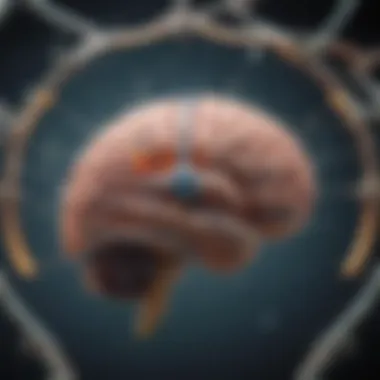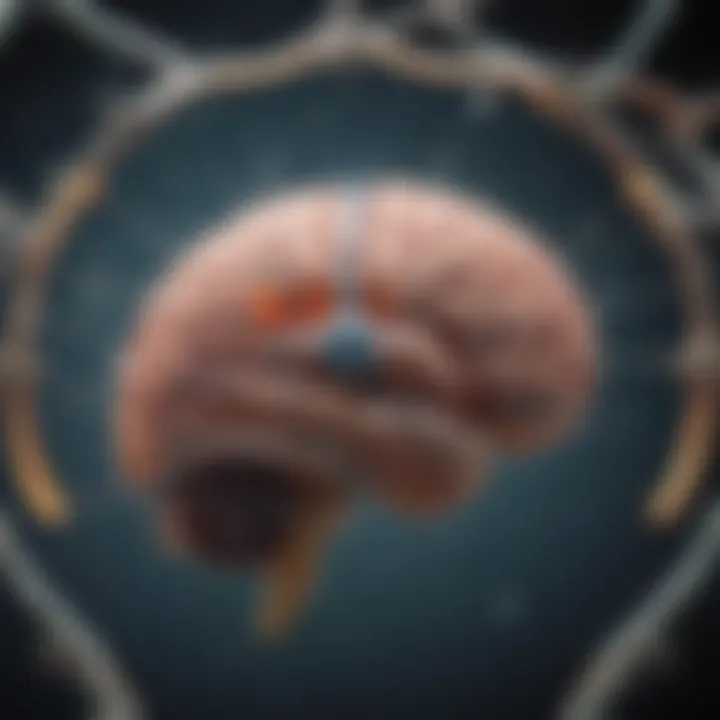Understanding Antidepressants: Mechanisms and Effects


Intro
The study of antidepressants is a critical area in understanding mental health disorders. Antidepressants play a key role in managing conditions like depression, anxiety, and other mood disorders. This has led to extensive research focused on how they function within the brain. The various types of antidepressants, such as selective serotonin reuptake inhibitors (SSRIs), serotonin-norepinephrine reuptake inhibitors (SNRIs), and atypical agents, exhibit different mechanisms of action that contribute to their therapeutic effects.
Understanding these mechanisms is more than a mere academic interest; it has real-world implications for treatment strategies and patient outcomes. In today’s complex landscape of pharmacotherapy, knowing how these medications target specific pathways can inform clinical decisions and guide the development of new treatment protocols.
This article will provide a thorough exploration of mechanisms by which these drugs operate, drawing insights into the biochemical underpinnings of antidepressant efficacy. Through this analysis, readers will gain a clearer appreciation of both the established and emerging antidepressant therapies available in current medical practice.
Intro to Antidepressants
Antidepressants play a significant role in the treatment of depression and related mood disorders. Their functionality is complex, involving various biochemical pathways. Understanding these mechanisms is crucial for anyone interested in mental health, pharmacology, or the intricacies of human psychology. This section emphasizes the importance of comprehending antidepressants, not just from a clinical angle but also from a broader perspective of public health. The effective use of these medications can lead to improved quality of life for those affected by depression, underscoring the necessity for continual education and awareness in this field.
Historical Background
The historical evolution of antidepressants dates back to the mid-20th century. The first significant class of antidepressants, the tricyclic antidepressants, emerged around the 1950s. Initially, these medications were discovered accidentally while researching other conditions. Their introduction revolutionized the treatment landscape for depressive disorders.
In the following decades, selective serotonin reuptake inhibitors (SSRIs) were introduced. SSRIs like fluoxetine and sertraline became popular due to their more favorable side effect profile compared to tricyclics. The development of such medications illustrates the continual advancement in psychiatric treatment. This historical progression also highlights the shifting understanding of depression as a medical condition, prompting a reevaluation of treatment methodologies over time.
Prevalence of Depression
Depression is one of the most prevalent mental health disorders globally, affecting millions of individuals regardless of age or background. According to the World Health Organization, over 264 million people suffer from depression. The increasing prevalence of this condition emphasizes the urgent need for effective treatment options, including antidepressants.
The high incidence rates present significant challenges for healthcare systems. In many regions, the stigma surrounding mental health can lead to underdiagnosis or delayed treatment. By addressing the prevalence of depression, we gain insight into the necessity of antidepressants in tackling this widespread issue.
"Understanding and addressing depression is not only a clinical concern but a societal imperative that requires collective action and awareness."
Understanding Depression
Understanding depression is crucial to comprehending how antidepressants function. Depression is not merely a transient emotional state; it is a complex mental health disorder that affects millions worldwide. Knowing the intricacies of depression enables better insights into how various antidepressants operate. By examining both the biological and psychosocial aspects of depression, we gain a broader perspective on why these medications are necessary and how they work.
Biological Basis of Depression
Depression is deeply rooted in biological systems, particularly the role of neurotransmitters in the brain. Neurotransmitters such as serotonin, norepinephrine, and dopamine are essential in mood regulation. An imbalance in these chemicals can result in the symptoms of depression. For instance, low levels of serotonin are often linked with increased feelings of sadness and despair. Understanding these mechanisms sheds light on why certain antidepressants target specific neurotransmitters to restore balance.
Research shows that individuals with depression may experience altered receptor sensitivity and availability. This abnormality affects the brain's ability to respond to neurotransmitters effectively. Modern antidepressant therapies frequently focus on correcting these imbalances, enhancing the overall efficacy of treatment. Therefore, knowledge of the biological basis not only supports the development of these medications but also informs clinicians about potential treatment outcomes based on a patient's distinct neurobiological profile.
Psychosocial Factors
While the biological aspects are essential, psychosocial factors cannot be overlooked when discussing depression. Life experiences, environmental influences, and social relationships play significant roles in shaping an individual’s mental state. Factors such as trauma, chronic stress, or significant life changes can contribute to the onset of depressive symptoms. Understanding these influences allows for a more holistic approach to treatment.
Moreover, psychosocial aspects can affect how a person responds to medication. For instance, individuals with strong social support networks may experience better outcomes with antidepressant therapy than those who feel isolated. Recognizing these variables is vital for clinicians aiming to develop personalized treatment plans.
In summary, both biological and psychosocial elements significantly shape the experience of depression. Through this understanding, the relevance of antidepressants becomes clearer, highlighting the need for tailored interventions that address both neurochemical and contextual factors in treatment.
"A comprehensive grasp of depression involves recognizing both its biological underpinnings and the psychosocial context in which it occurs."
By integrating insights from both areas, stakeholders can foster better treatment strategies that may ultimately enhance recovery and improve the quality of life for those affected.
Categories of Antidepressants
Understanding the categories of antidepressants is pivotal in comprehending their mechanisms and applications. Each category shares a common purpose, which is to alleviate the symptoms of depression, but they achieve this through different biochemical pathways.
The significance of these categories lies in their tailored approaches to treatment. Different patients respond uniquely to various medications. Hence, it is essential to categorize them for effective individualized care.
Selective Serotonin Reuptake Inhibitors
Mechanism of Action
Selective Serotonin Reuptake Inhibitors (SSRIs) function by increasing serotonin levels in the brain. By inhibiting the reuptake of serotonin at the synapses, SSRIs enhance the neurotransmitter's availability. This mechanism is effective in the treatment of depression and anxiety. The ability to boost serotonin makes SSRIs a popular choice among healthcare providers. Their unique feature is their selective action on serotonin without affecting other neurotransmitters greatly, reducing the risk of severe side effects associated with other antidepressants.
Common SSRIs
Common SSRIs include fluoxetine, sertraline, and escitalopram. These medications are known for their efficacy and relatively favorable side effect profile. Fluoxetine, for instance, is often noted for its long half-life, which can lead to more stable serotonin levels. Such characteristics bolster SSRIs' role in first-line treatments for depressive disorders. However, the individual responses can vary, necessitating careful monitoring and adjustment of dosages.


Efficacy and Side Effects
SSRIs are frequently well-tolerated, with akey characteristic being their balance of efficacy and safety. Patients often report an improvement in mood without experiencing crippling side effects. However, some adverse effects like nausea, insomnia, and sexual dysfunction are common. These can impede adherence to treatment in some patients, thus representing a drawback in the overall landscape of SSRIs.
Serotonin-Norepinephrine Reuptake Inhibitors
Mechanism of Action
Serotonin-Norepinephrine Reuptake Inhibitors (SNRIs) increase both serotonin and norepinephrine levels. By blocking the reuptake of these neurotransmitters, SNRIs improve mood and energy levels. This dual action can often lead to a more robust antidepressant effect, making SNRIs desirable in treating severe depression. Their unique feature lies in the broader neurotransmitter activity, which can be beneficial for patients not responding to SSRIs alone.
Common SNRIs
Common SNRIs include venlafaxine and duloxetine. These medications are recognized for their effectiveness in treating both anxiety and depression. Many practitioners favor SNRIs when SSRIs are inadequate. Nonetheless, SNRIs may carry more side effects, such as increased blood pressure. Hence, careful monitoring is necessary when prescribing them.
Comparison with SSRIs
The key difference between SNRIs and SSRIs is the neurotransmitters they target. SNRIs influence both serotonin and norepinephrine pathways, while SSRIs primarily affect serotonin. This distinction is relevant, as it can impact treatment efficacy. SNRIs might be preferred for patients with certain symptoms like fatigue or pain, as norepinephrine can aid energy levels. However, SSRIs may be the more suitable first choice for patients with primarily mood-related symptoms.
Atypical Antidepressants
Characteristics
Atypical antidepressants encompass a diverse range of medications that do not fit neatly into other categories. This broad classification allows for flexibility in treatment options. A unique feature of atypicals is their distinct mechanisms of action, which may vary widely from patient to patient. Such variability makes them particularly valuable for individuals who do not respond to traditional antidepressants.
Examples
Examples of atypical antidepressants include bupropion and mirtazapine. Bupropion, known for its dopamine-norepinephrine reuptake inhibition, is often chosen for patients experiencing significant fatigue and lack of motivation. Mirtazapine, conversely, may be used for patients who also struggle with sleep issues, as it can have sedative effects. Each drug has its advantages and disadvantages based on the unique symptoms of the patient.
Clinical Use
Clinicians often opt for atypical antidepressants for specific clinical situations, especially when first-line treatments fail. These medications can also be useful adjuncts in combination therapy. However, practitioners must weigh their unique profiles against potential side effects, which sometimes could include sedation or weight gain.
Tricyclic Antidepressants
Mechanism of Action
Tricyclic antidepressants (TCAs) function by blocking the reuptake of serotonin and norepinephrine, similar to SNRIs, but they also interact with various other neurotransmitter systems. This property can enhance therapeutic benefits for some patients. However, their broader action may lead to more side effects, such as anticholinergic effects like dry mouth or constipation. Their established efficacy makes them relevant but requires careful oversight.
Efficacy
The efficacy of TCAs is often well-documented, especially in chronic depression cases. They can be especially useful for patients with major depressive disorder who might not respond to other treatments. Nonetheless, their therapeutic window is narrower, and clinicians must exercise caution during prescription.
Side Effects
Common side effects of TCAs include sedation, weight gain, and potential cardiovascular issues. These effects often limit their use in some patient populations, particularly the elderly. But when used in a targeted manner, TCAs can provide life-changing benefits.
Monoamine Oxidase Inhibitors
Mechanism of Action
Monoamine Oxidase Inhibitors (MAOIs) work by inhibiting the monoamine oxidase enzyme, which is responsible for breaking down monoamines like serotonin and norepinephrine. This leads to increased levels of these neurotransmitters in the brain. Their effectiveness in atypical depression and treatment-resistant cases often makes them a last resort option. However, their use is limited by dietary restrictions and potential interactions.
Dietary Restrictions
Dietary restrictions play a significant role in the use of MAOIs. Patients must avoid tyramine-rich foods, such as aged cheeses and certain wines, to prevent hypertensive crisis. This necessity poses a challenge for adherence, as patients might struggle to remember or comply with such dietary limitations. Thus, while effective, MAOIs require thorough patient education and commitment.
Clinical Considerations
In clinical settings, the considerations surrounding MAOIs must account for their complex use. While they have proven benefits, the potential for adverse reactions necessitates close monitoring. Patients on MAOIs should be well-informed about possible interactions with other medications and dietary restrictions, making them suitable primarily for experienced practitioners.
Pharmacodynamics and Pharmacokinetics
Understanding pharmacodynamics and pharmacokinetics is crucial in the discussion of antidepressants. These concepts help explain how these medications work and their effects on the body.
Pharmacodynamics focuses on the action of the drug in the body. It looks into how antidepressants bind to neurotransmitters and alter their function, thus impacting mood and behavior. On the other hand, pharmacokinetics deals with how the body processes the medication. This includes absorption, distribution, metabolism, and excretion. Knowing both aspects ensures that practitioners can choose appropriate treatments for patients with depression.


Additionally, recognizing the interplay between pharmacodynamics and pharmacokinetics can help in understanding the efficacy of various antidepressants. For example, SSRIs are designed to increase serotonin levels in the brain. However, if the drug is poorly absorbed or rapidly eliminated from the body, its effectiveness may be reduced. Therefore, a deeper understanding of these mechanisms is imperative when addressing the treatment of depression.
Drug Absorption and Metabolism
The absorption of antidepressants begins once they enter the body, often through oral administration. Various factors can influence absorption, including the drug formulation and the presence of food. For instance, certain medications are better absorbed on an empty stomach, while others may require food to enhance absorption rates.
Once absorbed, the medications undergo metabolism primarily in the liver. The liver enzymes modify the drugs into active or inactive metabolites. This process significantly affects the overall effect of the antidepressants. For example, fluoxetine is a selective serotonin reuptake inhibitor that is extensively metabolized. Its active metabolite, norfluoxetine, can also contribute to the drug's antidepressant effects.
Moreover, individual differences in metabolism can lead to variations in drug efficacy and side effects among patients. Genetic factors play a role in how different individuals metabolize drugs, making pharmacogenetics an important consideration in treatment plans.
Duration of Action
The duration of action refers to how long an antidepressant exerts its therapeutic effects. This characteristic can greatly impact treatment strategies.
Some antidepressants, like SSRIs, may have a long half-life. This allows them to maintain stable levels in the bloodstream and lead to sustained effects. However, others may have a shorter duration, potentially requiring more frequent dosing.
An important aspect regarding the duration of action is the potential for withdrawal symptoms. If a patient stops taking their medication abruptly, it can lead to negative effects. Thus, it is recommended that patients taper off.
In summary, the duration of action must be considered carefully in the context of patient compliance and overall treatment effectiveness. The right choice can significantly affect the success of antidepressant therapy.
The Role of Neurotransmitters
Neurotransmitters are chemicals that facilitate communication between neurons in the brain. Their role in mood regulation and emotional stability is critical, especially in understanding how antidepressants work. This section elaborates on the three primary neurotransmitters involved in depression and the detrimental impact of their imbalance: serotonin, norepinephrine, and dopamine. By recognizing their unique roles, one can appreciate how antidepressants aim to alleviate depressive symptoms through targeted modulation of these neurotransmitter systems.
Serotonin
Serotonin is one of the most studied neurotransmitters in relation to depression. It influences various functions, including mood, sleep, and appetite. Low levels of serotonin are commonly associated with depressive disorders. Selective Serotonin Reuptake Inhibitors (SSRIs), a widely used class of antidepressants, primarily work by increasing serotonin levels in the synaptic cleft. They inhibit the reuptake of serotonin, allowing for prolonged activity at the receptor sites.
The significance of serotonin cannot be overstated. It is linked to the regulation of mood, emotion, and cognitive functions. Consequently, understanding its mechanisms can provide insight into the effectiveness of SSRIs and their role in treating depression.
Norepinephrine
Norepinephrine acts as both a neurotransmitter and a hormone. It is vital in responding to stress and has a role in regulating alertness and arousal. In the context of depression, a deficiency in norepinephrine may contribute to feelings of lethargy and lack of motivation. Serotonin-Norepinephrine Reuptake Inhibitors (SNRIs) increase the levels of both serotonin and norepinephrine in the brain, addressing a broader range of depressive symptoms.
SNRIs not only elevate mood but also enhance energy levels and focus. This dual action makes them an essential option for individuals exhibiting significant fatigue and cognitive dulling alongside their depressive symptoms.
Dopamine
Dopamine is often referred to as the "feel-good" neurotransmitter due to its role in the pleasure and reward systems. It is implicated in motivation, reward, and the experience of enjoyment. Research indicates that low levels of dopamine can lead to anhedonia, a core symptom of depression characterized by a loss of interest or pleasure in activities.
Atypical antidepressants, such as bupropion, target the dopamine system, making them effective for patients who do not respond well to traditional SSRIs or SNRIs. By modulating dopaminergic pathways, these medications can restore motivation and improve overall mood.
It is crucial to recognize the interconnectedness of these neurotransmitters. Their imbalance can significantly affect mental health, leading to a broader understanding of treatment options.
Efficacy of Antidepressants
The efficacy of antidepressants is a critical aspect of understanding their role in treating depression and similar disorders. Efficacy refers to how well a medication works in clinical settings, and it encompasses both immediate symptoms relief and longer-term management of mood disorders. To fully appreciate antidepressants, one must consider numerous elements, including the types of antidepressants available, how they affect neurotransmitter levels, and the individual responses to these medications.
Antidepressants can significantly improve the quality of life for many patients. They are intended to alleviate symptoms like sadness, anxiety, and apathy, allowing individuals to regain functioning in daily activities. However, not all patients respond favorably to the same drug. This variability highlights the importance of personalized medicine. It is essential to identify which medication or combination of medications will offer the best results for each individual.
Comparative Studies
Comparative studies are vital for assessing the efficacy of different antidepressants. These studies often involve clinical trials that measure how various medications perform against each other. The research typically focuses on the following elements:
- Response Rate: This measures the percentage of patients who experience a significant reduction in symptoms during treatment.
- Remission Rate: This assesses the percentage of patients whose symptoms disappear entirely or are reduced to a level that is clinically insignificant.
Most studies focus on Selective Serotonin Reuptake Inhibitors (SSRIs) and Serotonin-Norepinephrine Reuptake Inhibitors (SNRIs). Research shows that while SSRIs like Fluoxetine (Prozac) and Sertraline (Zoloft) are effective and have a lower risk of serious side effects, SNRIs such as Venlafaxine (Effexor) may offer additional benefits for specific patients, particularly those with both depressive and anxiety symptoms.
"Understanding varying efficacy rates is essential for making informed treatment choices for patients suffering from depression."
Patient-Reported Outcomes
Patient-reported outcomes (PROs) are crucial in determining the real-world efficacy of antidepressants. These measures focus on how patients perceive their symptoms and the impact of the medication on their quality of life. PROs can include:


- Symptom Relief: Patients often describe their mood changes, sleep quality, and levels of anxiety after starting new medication.
- Functioning: Improvements in daily activities, including work performance and social interactions, are critical indicators of treatment success.
- Side Effects: Patients frequently report their experiences with side effects, which can influence their willingness to continue specific treatments.
Collecting and analyzing PROs can provide insight into both the subjective and objective benefits of antidepressant therapy. This data is invaluable not only for clinicians in tailoring treatment plans but also for researchers striving to understand which medications provide the most significant benefits to specific populations.
Understanding both comparative data and patient experiences sheds light on how antidepressants work. This in turn aids in refining treatment protocols that enhance efficacy and reduce the burden of depressive symptoms for patients.
Adverse Effects and Safety
The topic of adverse effects and safety is crucial when discussing antidepressants. These medications play a significant role in managing depression, yet they come with potential risks that can impact patient adherence to treatment regimens. Understanding the side effects and serious risks associated with these medications is essential for patients and healthcare providers. This section will address the common side effects of antidepressants and the more serious risks that can arise.
Common Side Effects
When patients begin a course of antidepressant therapy, it is important to monitor for common side effects. These can vary depending on the specific class of antidepressants prescribed. Common side effects include:
- Gastrointestinal Disturbances: Patients often report nausea, diarrhea, or constipation.
- Fatigue or Drowsiness: A sense of tiredness can occur, affecting daily activities.
- Insomnia: Difficulty falling or staying asleep may also be reported.
- Weight Changes: Some patients experience weight gain or loss as a result of medication.
- Sexual Dysfunction: Issues such as decreased libido or difficulty achieving orgasm are not uncommon.
- Dry Mouth: This can lead to discomfort, affecting eating and speaking.
Recognizing and discussing these common side effects openly can help manage patient expectations and encourage adherence to treatment. Regular follow-up appointments allow for adjustments in medication if side effects significantly impact the patient’s quality of life.
Serious Risks
While common side effects can often be managed, serious risks associated with antidepressant use pose more significant concerns. Awareness of these risks is vital for both patients and healthcare providers. Serious risks may include:
- Increased Suicidal Thoughts: Particularly in young adults and children, some antidepressants can increase suicidal ideation, especially during the early phases of treatment.
- Serotonin Syndrome: This potentially life-threatening condition can result from too much serotonin in the brain, presenting symptoms like agitation, high body temperature, or increased heart rate.
- Withdrawal Symptoms: Discontinuation of antidepressants can lead to withdrawal symptoms, including flu-like signs, mood swings, or dizziness.
- Bleeding Risks: Some antidepressants might increase the risk of bleeding, particularly in patients taking aspirin or other anticoagulants.
Awareness of these serious risks should prompt healthcare providers to evaluate the patient’s mental health status continuously.
Both common side effects and serious risks highlight the need for careful monitoring of patients on antidepressants. Knowledge of these elements can foster informed conversations between patients and healthcare providers, ultimately leading to safer and more effective treatment strategies.
Future Directions in Antidepressant Research
As the field of psychopharmacology continues to evolve, exploring future directions in antidepressant research becomes increasingly critical. This section highlights emerging trends and potential advancements in antidepressant therapies. Emphasizing innovative approaches may lead to novel strategies in treating depression and related disorders.
Research on antidepressants needs to focus not just on existing medications but also on the development of new compounds. The safety and efficacy of current antidepressants often come with limitations. Many patients do not respond favorably to traditional therapies, creating an urgency for alternatives.
New Compounds in Development
In recent years, scientists have turned their attention to various new compounds in development. These are designed to target specific mechanisms in the brain associated with depression. For instance, compounds that modulate the glutamate system show promise. Studies suggest that these may quickly alleviate symptoms in treatment-resistant cases of depression. Research also investigates compounds like esketamine, a nasal spray that represents a significant shift in treatment approaches. It works differently from most traditional antidepressants, aiming to offer faster relief from depressive symptoms.
The identification and synthesis of new molecules often rely on advanced screening methods and computational models. These tools enhance the ability to discover agents that interact with molecular targets in more effective ways. Additionally, selective serotonin and norepinephrine modulating compounds are in the pipeline.
"The rapid development of new antidepressants reflects the urgency to find effective treatments for mental health conditions."
Personalized Treatment Approaches
Another significant aspect of future research involves personalized treatment approaches. Each patient has unique biological and psychosocial factors that influence their response to medication. Tailoring treatment to the individual's profile can enhance efficacy while minimizing side effects. This approach is gaining traction in clinical settings, as it allows for more precise management of depression.
Techniques such as pharmacogenomics play a vital role here. By analyzing how a person’s genes affect their response to medications, clinicians can make more informed decisions about treatment plans. Furthermore, understanding the diverse nature of depression enables the integration of lifestyle factors into treatment strategies.
Developing better screening tools to identify the most promising treatment options for each patient also creates opportunities for more successful interventions. Involving patients in treatment planning fosters collaboration and adherence to their care plans.
In summary, future directions in antidepressant research encompass both the development of new compounds and the implementation of personalized treatment strategies, which present exciting possibilities for improving mental health outcomes.
Finale and Implications for Treatment
The exploration of antidepressants through the lens of their mechanisms of action lends profound insights into their functionality. This article elucidates the biochemical pathways and pharmacodynamics responsible for the therapeutic effects of various antidepressant categories, such as SSRIs, SNRIs, and atypical agents.
Understanding these mechanisms critically informs clinical practices and patient management. By comprehensively examining how these medications interact with neurotransmitter systems, medical professionals can make more informed decisions regarding treatment options. Equally, recognizing the efficacy and side effect profiles ensures a balanced approach in prescribing therapies, aligning with individual patient needs.
"Thorough knowledge of antidepressant mechanisms can enhance treatment strategies and patient outcomes."
In addition, constant research developments are unveiling new compounds and personalized treatment strategies. This continuous evolution in the landscape of antidepressant therapies augments the importance of staying updated in practice.
Summary of Key Findings
- Mechanisms of Action – Detailed understanding of how antidepressants modulate neurotransmitters provides clarity on their efficacy in treating depression.
- Efficacy and Safety – Evidence demonstrates varied response rates in individuals, emphasizing the need for personalized treatment combinations.
- Emerging Therapies – New compounds and personalized approaches are critical as they promise improved outcomes, especially for treatment-resistant depression.
Considerations for Practice
- Individual Variability – Antidepressant effectiveness can vary widely among individuals; tailor treatment based on genetic, biological, and psychosocial factors.
- Monitoring Treatment – Regular follow-ups are necessary to assess efficacy and side effects, adjusting treatment as needed to maximize benefits and minimize risks.
- Patient Education – Inform patients about potential side effects and encourage open dialogue regarding their experiences with the medication. This can enhance adherence to treatment plans.
- Stay Updated – Engage in ongoing education regarding new research and advances in antidepressant therapies, further enhancing clinical effectiveness.
The insights and considerations presented herein serve as essential tools for healthcare providers, guiding effective treatment strategies in the challenging realm of depression management.















